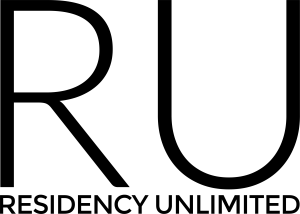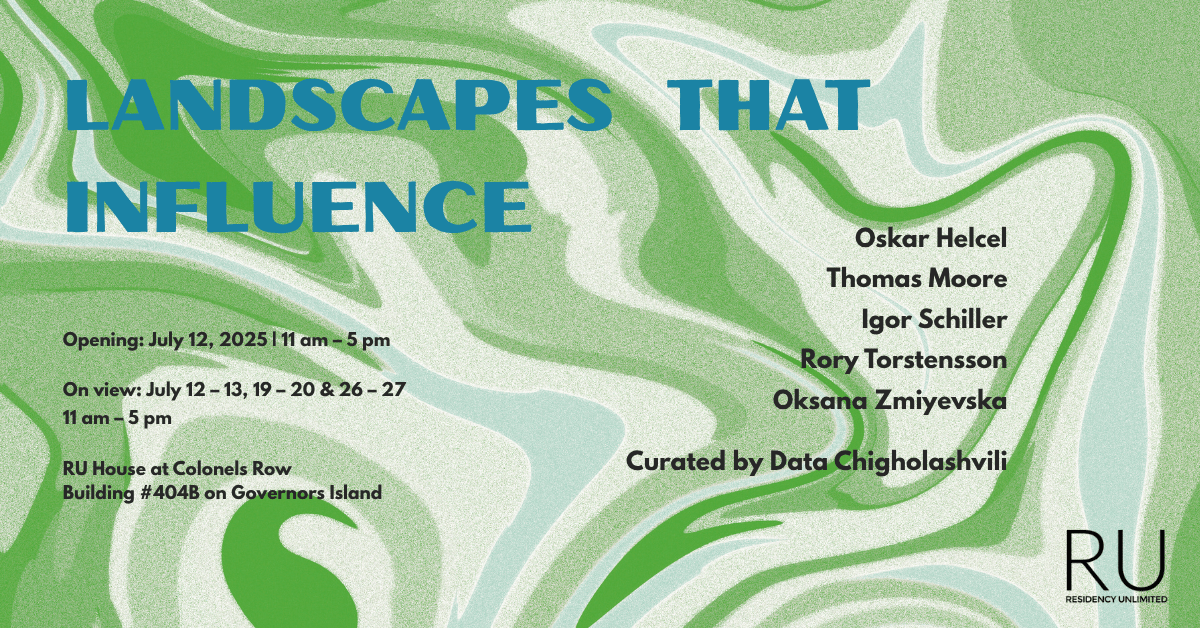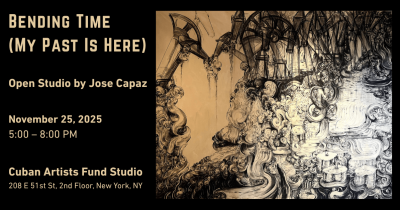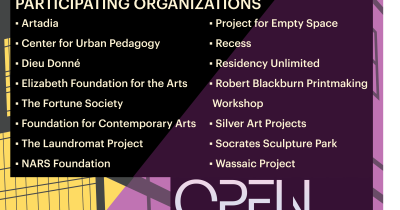Opening: July 12, 2025 | 11am – 5pm
On view: July 12-13, 19-20 & 26-27 | 11am – 5pm
Weekday visits by appointment (email info@residencyunlimited.org)
Location: RU House at Colonels Row, Building #404B on Governors Island (map)
Ferry information | Video directions
Please join us for the group exhibition featuring works by RU resident artists: Oskar Helcel, Thomas Moore, Igor Schiller, Rory Torstensson, and Oksana Zmiyevska. “Landscapes That Influence” is curated by Data Chigholashvili, Curator of Residency Unlimited.
An inherent relationship develops with the landscapes that we inhabit. As we transform our environments, they also merge with mindscapes, establishing an interconnected influence that continues in new contexts that one lives in or passes through. Artworks in this exhibition oscillate between personal and collective landscapes. Visitors encounter topics such as memories, areas, and terrains that affect the artists’ gaze, even if those from the distant past sometimes require reconciliation. Themes such as liminality, navigating urban settings, natural and mental scenes, spaces of industrial solitude, and future imaginaries also emerge in the selection of works presented in this former residential house, situated on Governors Island in New York Harbor. The exhibition explores the above through the interpretations of physical and emotional landscapes, those that stay with us, and those in the memories of which we reside.
In the “Suburban Industry” photo series, Thomas Moore presents mysterious landscapes and structures from Connecticut; however, humans are nowhere to be seen. These images have that feeling of driving in the countryside and catching a glimpse of an enigmatic building standing alone. Photographed at golden hour and having a rather nostalgic touch, these photographs explore natural and built environments, and make time ambiguous in them. In the video work “Project Zaha: It’s Buildable,” Oskar Helcel critically examines a controversial development next to the Masaryk Station in his hometown Prague, Czech Republic. The project by the late “starchitect” Zaha Hadid’s studio was accompanied by protests, delays, and changes. In the video, we see a sole body – the artist impersonating the architect – wandering around a liminal construction site. Questioning digital imaginaries, rapid urban transformation, and people’s place in them today, the artist asks whether everything is really buildable?
Home and its continual influence on artists’ journeys through different places is an essential topic in another group of artworks in the exhibition. Oksana Zmiyevska’s paintings intertwine observations of the outside world and personal mindscapes, at times referencing memories or projections of living in Ukraine. In her works, we see bodies in environments that might seem phantasmic, making spectators question if they depict moments of joy, trouble, or confusion. Sometimes through purposefully chosen anti-aestheticism, she explores personal mindscapes, and with irony and honesty invites others to self-reflection. The influence of childhood landscapes permeates the works of Rory Torstensson. Her figurative paintings combine the layers of personal narratives and the artist’s special relationship to the ocean, which she developed growing up in a coastal town in Massachusetts. In her works, we find figures, often self-portraits, referencing life by the water and searching for connections with oneself and others. She also presents studies of weaving seaweed, which comes as a metaphor of seeking support networks and belonging. Searching for oneself is the core idea in the work of Igor Schiller that follows the hero’s journey, a common template in storytelling. This video installation features fragments from his trilogy’s second film, currently in the making, where the artist uses the visual language of fairy tales, and fictionalizes personal stories and environments from growing up in Serbia. It hints at that feeling of leaving the familiar, exploring, learning, transforming, and anticipating going back to home landscapes.
Click above to see the images from the program
Short bios of artists (for more information, please follow the links to RU profiles):
Oskar Helcel is an audiovisual artist, photographer, and performer. His artistic work focuses on the mechanisms of late capitalism in the context of contemporary urban space. He has long worked with the topic of so-called “developerism” as a tool for the reproduction of capitalism, the privatization of cities for profit, and gentrification. His performative video essays reveal class and economic inequality, often in connection with specific locations to which he repeatedly returns. The broader social issues are interconnected with more intimate processes of perception such as the need for a home, the confrontation between the individual and corporations, and the emotional imbalance of real estate developers. Oskar Helcel is the laureate of the 2024 Jindřich Chalupecký Award.
Thomas Moore’s recent work has involved community, community building, and human interaction as core components. Since 2005, his practice has focused primarily on a series of photographs entitled “The Past Inside the Present” that consists of images of his immediate and extended family in Florida, Connecticut, Maine, and Ohio, and the surrounding environments. In this body of work, Thomas has attempted to describe a specific type of narrative that explores a sense of mystery and the unknown – a feeling that something perhaps unknowable is lurking just beneath the surface of everyday American experience.
Igor Schiller is a Serbia-born and Amsterdam-based artist. Rooted in the rich traditions of his Balkan upbringing, Schiller explores themes of cultural identity, memory, and how childhood shaped his worldview. Revisiting his early years through his family archive, he blends fictional and subjective elements to create elaborate cinematic sets, saturated with strangeness and gloom, yet contrasted with tenderness and warmth. He views toys, lullabies, games, and other remnants of childhood as historical artefacts that reflect the socio-political climate. By analysing their influence on children’s content, he explores how they perpetuate cultural legacies shaped by rigid systems. Igor Schiller is the winner of the 2024 Dimitrije Bašičević Mangelos Award.
Rory Torstensson is a figurative and narrative artist whose work explores themes of childhood by the ocean, her Jewish identity, and the relationships she has gained and lost over time. Her paintings engage with notions of belonging, friendship, and intimacy between family and friends, using these connections as a central muse. Balancing the historical weight of figurative painting with contemporary struggles of personal agency and the need for emotional support networks, Rory emphasizes the physicality and process of painting as integral to her practice. Her expressive brushwork and attention to detail bring a sense of pleasure to the viewing experience, allowing her work to oscillate between joy and mourning.
Oksana Zmiyevska’s body of work explores portraiture as a political and psychological genre. When it comes to self-portraits, Zmiyevska candidly exposes vulnerability and self-criticism, but also admiration and experience of self-intimacy. Partly painted from her private archive, sometimes referencing to the great masters, or just sketched in front of a mirror, she delves into the complexity of boredom and excitement of having this one particular body, this one particular face—the one you know the most, yet the one that still surprises you. In multi figure compositions, Zmiyevska develops imagery of intensity of being together. Whether it is a sensual moment between two, or a basketball match, or castellers, or gamblers in a casino, the artist always focuses on the event of nearness to the others and the ambiguity of it. (Text by Liudmila Kirsanova)
This program is supported by the Trust for Mutual Understanding.

RU is grateful for the partnership with Governors Island Arts.







